

If the applied range is larger than what you need, then consider limiting it to only the required data range. Go to Conditional Formatting > Manage Rules and check the cell range of each of the rules. One mistake some Excel users make is to apply formatting to an entire sheet, or an entire group of rows or columns. 5. Double check Conditional Formatting rangesĬonditional Formatting is a fantastic way to visually compare any changes in numbers in data ranges, but it can come at a hefty price – a bloated Excel file! Formatting such as borders, highlighting and unique fonts are good examples to remove. Be careful of using the Clear Formats options to do this – you will also strip out any date or currency formats from data which can be confusing (eg: Jan 1st 2016 will change to ‘42370’). I can think of a few ex-bosses of mine who would hate me if I removed any formatting from files that we gave to our clients, but if it’s an internal working file, then avoid formatting it just to make it look pretty for you. Of course, your job or assignment may require the data to be presented in a specific way – but if it will never be viewed directly and only needs to be used for calculation purposes, then remove as much formatting as possible. If your raw data contains formatting, then it’s going to increase the file size in Excel. Sometimes you can reduce files down to 20% of their original file size! 4. xlsb format, but this will vary depending on what kind of data is in the file. Most files will get a reduction in file size of roughly 50% by saving it in the. If you have an Excel file with lots of raw data and lots of formulas, go and save it in the Excel binary format (.xlsb).Īny Macros and VBA will still be retained in this format, so you don’t have to worry about loss of functionality. I’ve hidden the best way to reduce file size down at #3. You can reduce the file size of your Excel workbook by unhiding all sheets, and checking if you still require that data or not.ģ. If you have received an Excel file from someone else, they may have hidden some additional sheets as part of the file, but hidden them for some reason. Check for and delete unnecessary hidden sheets If you press Ctrl + End again, the last used cell should now be next to the cells you just deleted. In older versions of Excel, you’ll need to save the file after deleting the unnecessary rows and columns. Do NOT simply press the Delete button – it won’t have the same effect, all it will do is clear the contents of the cells!
#Excel for mac reference another workbook without opening how to#
(Note: to get this result, I simply entered a value in cell K20 then deleted it.) How to Fix the “Used Range” in Excel I’ve got data that goes until column F and row 11, so I should expect that the used range goes until cell F11 (even if nothing is in that specific cell).īut when I press Ctrl + End, this happens:

If that shortcut takes you many rows (or columns) past the end of your data, it means that all of those cells are increasing the file size for no reason. If you press Ctrl + End on any sheet in your Excel file, you can see what the “last used cell” is. But as you work on a file, it will increase to represent the rightmost column and furthest row that you’ve edited or formatted.Įspecially in older files, even if cells are blank and have no formatting, Excel may be treating them inside the used range, leading to a larger file size for no reason. The larger this is, the bigger the file size becomes.įor new & blank Excel files, the used range is only cell A1. This is definitely the most common source of large Excel file sizes, and fortunately one of the easiest to fix.Įxcel has a “used range” for every sheet in your workbook. If you don’t want to alter the contents of the workbook, try these options first. In this section are the easy and straightforward options to cut down on file size.



 0 kommentar(er)
0 kommentar(er)
